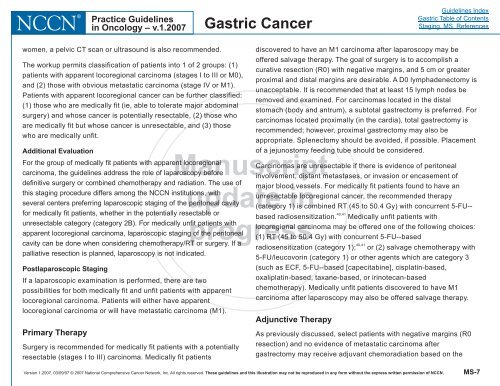Practice Guidelines in Oncology - Gastric Cancer
Practice Guidelines in Oncology - Gastric Cancer
Practice Guidelines in Oncology - Gastric Cancer
Create successful ePaper yourself
Turn your PDF publications into a flip-book with our unique Google optimized e-Paper software.
®<br />
<strong>Practice</strong> <strong>Guidel<strong>in</strong>es</strong><br />
NCCN <strong>in</strong> <strong>Oncology</strong> – v.1.2007<br />
women, a pelvic CT scan or ultrasound is also recommended.<br />
The workup permits classification of patients <strong>in</strong>to 1 of 2 groups: (1)<br />
patients with apparent locoregional carc<strong>in</strong>oma (stages I to III or M0),<br />
and (2) those with obvious metastatic carc<strong>in</strong>oma (stage IV or M1).<br />
Patients with apparent locoregional cancer can be further classified:<br />
(1) those who are medically fit (ie, able to tolerate major abdom<strong>in</strong>al<br />
surgery) and whose cancer is potentially resectable, (2) those who<br />
are medically fit but whose cancer is unresectable, and (3) those<br />
who are medically unfit.<br />
Additional Evaluation<br />
For the group of medically fit patients with apparent locoregional<br />
carc<strong>in</strong>oma, the guidel<strong>in</strong>es address the role of laparoscopy before<br />
def<strong>in</strong>itive surgery or comb<strong>in</strong>ed chemotherapy and radiation. The use of<br />
this stag<strong>in</strong>g procedure differs among the NCCN <strong>in</strong>stitutions, with<br />
several centers preferr<strong>in</strong>g laparoscopic stag<strong>in</strong>g of the peritoneal cavity<br />
for medically fit patients, whether <strong>in</strong> the potentially resectable or<br />
unresectable category (category 2B). For medically unfit patients with<br />
apparent locoregional carc<strong>in</strong>oma, laparoscopic stag<strong>in</strong>g of the peritoneal<br />
cavity can be done when consider<strong>in</strong>g chemotherapy/RT or surgery. If a<br />
palliative resection is planned, laparoscopy is not <strong>in</strong>dicated.<br />
Postlaparoscopic Stag<strong>in</strong>g<br />
If a laparoscopic exam<strong>in</strong>ation is performed, there are two<br />
possibilities for both medically fit and unfit patients with apparent<br />
locoregional carc<strong>in</strong>oma. Patients will either have apparent<br />
locoregional carc<strong>in</strong>oma or will have metastatic carc<strong>in</strong>oma (M1).<br />
Primary Therapy<br />
Surgery is recommended for medically fit patients with a potentially<br />
resectable (stages I to III) carc<strong>in</strong>oma. Medically fit patients<br />
<strong>Gastric</strong> <strong>Cancer</strong><br />
Manuscript<br />
update <strong>in</strong><br />
progress<br />
Version 1.2007, 03/09/07 © 2007 National Comprehensive <strong>Cancer</strong> Network, Inc. All rights reserved. These guidel<strong>in</strong>es and this illustration may not be reproduced <strong>in</strong> any form without the express written permission of NCCN.<br />
<strong>Guidel<strong>in</strong>es</strong> Index<br />
<strong>Gastric</strong> Table of Contents<br />
Stag<strong>in</strong>g, MS, References<br />
discovered to have an M1 carc<strong>in</strong>oma after laparoscopy may be<br />
offered salvage therapy. The goal of surgery is to accomplish a<br />
curative resection (R0) with negative marg<strong>in</strong>s, and 5 cm or greater<br />
proximal and distal marg<strong>in</strong>s are desirable. A D0 lymphadenectomy is<br />
unacceptable. It is recommended that at least 15 lymph nodes be<br />
removed and exam<strong>in</strong>ed. For carc<strong>in</strong>omas located <strong>in</strong> the distal<br />
stomach (body and antrum), a subtotal gastrectomy is preferred. For<br />
carc<strong>in</strong>omas located proximally (<strong>in</strong> the cardia), total gastrectomy is<br />
recommended; however, proximal gastrectomy may also be<br />
appropriate. Splenectomy should be avoided, if possible. Placement<br />
of a jejunostomy feed<strong>in</strong>g tube should be considered.<br />
Carc<strong>in</strong>omas are unresectable if there is evidence of peritoneal<br />
<strong>in</strong>volvement, distant metastases, or <strong>in</strong>vasion or encasement of<br />
major blood vessels. For medically fit patients found to have an<br />
unresectable locoregional cancer, the recommended therapy<br />
(category 1) is comb<strong>in</strong>ed RT (45 to 50.4 Gy) with concurrent 5-FU--<br />
40,41<br />
based radiosensitization. Medically unfit patients with<br />
locoregional carc<strong>in</strong>oma may be offered one of the follow<strong>in</strong>g choices:<br />
(1) RT (45 to 50.4 Gy) with concurrent 5-FU--based<br />
40,41<br />
radiosensitization (category 1); or (2) salvage chemotherapy with<br />
5-FU/leucovor<strong>in</strong> (category 1) or other agents which are category 3<br />
(such as ECF, 5-FU--based [capecitab<strong>in</strong>e], cisplat<strong>in</strong>-based,<br />
oxaliplat<strong>in</strong>-based, taxane-based, or ir<strong>in</strong>otecan-based<br />
chemotherapy). Medically unfit patients discovered to have M1<br />
carc<strong>in</strong>oma after laparoscopy may also be offered salvage therapy.<br />
Adjunctive Therapy<br />
As previously discussed, select patients with negative marg<strong>in</strong>s (R0<br />
resection) and no evidence of metastatic carc<strong>in</strong>oma after<br />
gastrectomy may receive adjuvant chemoradiation based on the<br />
MS-7

















